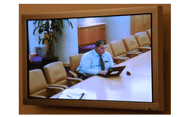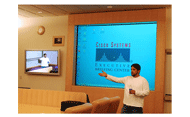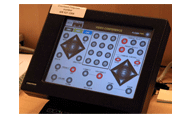With the ever-increasing costs of travel, concerns about efficiency, and the need for employees to juggle many tasks at once to keep up with their responsibilities, enterprises are continually seeking solutions that use technology to improve the productivity of business and technical groups. Like many other large, global companies, Cisco Systems® maintains teams whose members are located around the world. These teams must find efficient, cost-effective ways to communicate.
Al Navas, operations manager for the Carrier-Class Multiple Services Business Unit (CCMSBU) at Cisco®, sees the challenges of maintaining a close working relationship among teams spread out from San Jose, California, to Ottawa, Canada, to Israel. E-mail and telephone are certainly important tools, but more is needed to provide a personal contact.
Video conferencing is the ideal medium for effective communications between geographically dispersed teams. Cisco uses an IP-based video conferencing (IP/VC) solution with approximately 800 IP/VC endpoints deployed at worldwide Cisco locations, with an average usage of 700,000 minutes per month. "Our team uses video conferencing whenever possible," says Navas. "Body language is important. It's helpful to the person giving a presentation to be able to see their audience and their reaction to what is being said."
Cisco offers numerous IP/VC solutions that are available in different formats, based on network connectivity protocols. The current IP/VC solution deployed within Cisco uses the H.323 protocol suite, which defines the protocols to provide audio-visual communications sessions on any packet network. Many vendors implement H.323 in their products.
The end-user operation of an IP/VC device or endpoint is similar to the operation of a television with a remote control. Each IP/VC endpoint is assigned a unique dial number. A special device known as an H.323 gatekeeper stores these numbers and matches the dial number to the IP address of the device that is dialed. When a number is dialed, the IP/VC endpoint requests access information from the gatekeeper. The gatekeeper looks up the appropriate IP address and sends that information back to the requesting endpoint. The requesting endpoint then initiates a session directly with the destination endpoint.
Al Navas,
Operations Manager, Cisco Carrier-Class Multiple Services Business Unit
A multiparty IP/VC session is initiated much like a multiparty voice conference call. A unique conference number is scheduled and provided to all participants. Each participant dials this number from their IP/VC endpoint. The dial number is matched to the IP address of the multipoint control unit (MCU) by the gatekeeper. All endpoint sessions are connected through the MCU.
The CCMSBU conducts regular program commitment meetings between San Jose, Israel, and Ottawa. These teams use a room-based video conferencing system on the San Jose campus for their meetings. Another group within the same business unit has begun conducting strategy review meetings between San Jose and the Cisco office in Bangalore, India. The CCMSBU also holds regular "all-hands" meetings using video conferencing. Following is the process for the San Jose-Israel-Ottawa meetings:
The vice president of CCMSBU calls into the conferencing service through the video conferencing unit in his office and uses Web conferencing software to present his slides.
Navas manages the meeting from his office. He is connected and "chatting" with all locations through the Sametime instant messaging application.
Three remote groups of participants in conference rooms in San Jose, Israel, and Ottawa can view the presentation and other participants during the meeting, and can ask and answer questions.
Figures 1-3 show different components of the video conferencing process.
The benefits of using visual references to clarify and improve communication among participants are well-documented. For example:
Increased learning: Attendees learn 200 percent more in face-to-face meetings than with audio alone. (Source: University of Wisconsin)
Improved rate of absorption: Attendees absorb information up to 40 percent faster in face-to-face meetings than with audio alone. (Source: Wharton School of Business)
Augmented content retention: Attendees in face-to-face meetings retain 38 percent more information than attendees using audio alone. (Source: Harvard University and Columbia University.)
Enhanced persuasiveness: Face-to-face meetings increase the power of persuasion by 43 percent over audio-only meetings. (Source: 3M Co.)
Improved impact of communication: 55 percent of the impact of communications comes from facial expressions and body language, versus 38 percent from vocal inflection. (Source: UCLA)
After using video conferencing for many years, Navas has learned a few lessons that make the service more effective:
Multiple locations: You must introduce video conferencing in multiple locations for it to be useful as an internal communications tool. "If I can walk down the hall, I'd rather do that," says Navas.
Executive-level acceptance: If executives support and use video conferencing, it is more likely that it will be adopted across the organization.
Real-time support: Someone must be present that can immediately respond to problems that might occur during a video conference.
Ease of use: Video conferencing must be easy to set up and operate.
"When you book the conference room, all the resources should be booked at the same time - automatically," says Navas. "When you walk into the conference room, you should only have to push one or two buttons and it's all connected and operating."
At Cisco, video conferencing has been shown to be effective in enabling better communications between teams that are geographically dispersed, resulting in more effective interactions and improved productivity.
For more information about how Cisco video conferencing works, visit:
http://www.cisco.com/en/US/solutions/ns669/telepresence_video_conferencing_system.html


